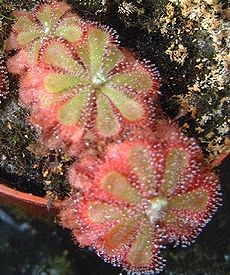- Drosera aliciae
-
Drosera aliciae 
Scientific classification Kingdom: Plantae (unranked): Angiosperms (unranked): Eudicots (unranked): Core eudicots Order: Caryophyllales Family: Droseraceae Genus: Drosera Species: D. aliciae Binomial name Drosera aliciae
R.Hamet (1905)Synonyms - Drosera aliciae
auct. non R.Hamet: R.Hamet (1907)
[=Drosera aliciae/Drosera natalensis] - Drosera aliciae
auct. non R.Hamet: Oberm. in sched. (1985) [=Drosera slackii] - Drosera curviscapa
Salt. (1939) - Drosera curviscapa var. esterhuyseniae
Salt. (1944) - Drosera esterhuyseniae
(Salt.) Debbert (1991) - ?Drosera rubrifolia
Debbert (2002) - Drosera spathulata
Hort. ex Behre (1929)
[=Drosera aliciae/Drosera spatulata]
Drosera aliciae, the Alice sundew, is a carnivorous plant in the family Droseraceae. It is native to South Africa, like Drosera capensis, the cape sundew, and is one of the most common sundews in cultivation. The plant forms small, tight rosettes of wedge-shaped leaves, up to 5 cm in diameter. Under conditions of good lighting, the insect-snagging tentacles will become deeply coloured with anthocyanin pigments, which probably aid in its attraction of insect prey. The plant is relatively easy to grow, and produces attractive scapes of pink flowers, which are held about 30 cm away from the carnivorous leaves, so as to prevent pollinators from becoming ensnared. D. aliciae is very similar in form to a number of other closely related species such as D. slackii, and D. dielsiana: the former is rather larger (8 cm diameter); the latter rather smaller (3 cm diameter).
Categories:- Carnivorous plants of Africa
- Drosera
- Flora of South Africa
- Drosera aliciae
Wikimedia Foundation. 2010.


